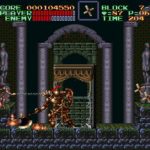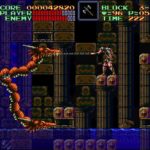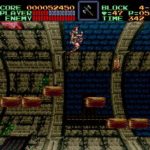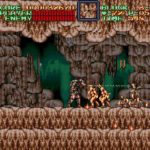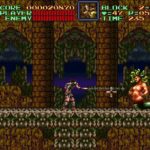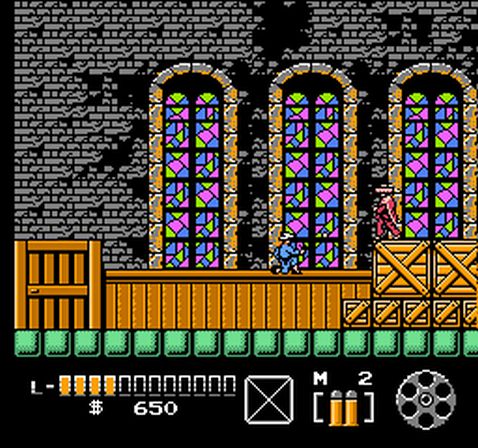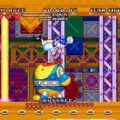Developer: Konami Publisher: Konami Released: 10/31/91 Genre: Action
When I look back on the first year of the Super Nintendo’s release I realize we’ll likely never have another system with a year of insane releases like that ever again. Aside from new intellectual properties many beloved classics received 16-bit sequels such as Contra, Ghouls N Ghosts, and especially Castlevania. The double combo of Nintendo Power screenshots and Gamepro TV show footage sent my hype through the roof. It would take a few months after the SNES launched before I finally got my hands on Super Castlevania IV and it surpassed my expectations.
Story wise this is considered a remake of Simon Belmont’s first adventure. Granted it’s not as though there was any exposition in the original game but it does serve as a nice introduction for those new to the series which is entirely the point. Very little of the original Castlevania is actually present here to the point where you could even consider a different game. Castlevania IV introduces a number of new mechanics that are both quality of life improvements and a bit controversial. Regardless of your opinion no one can deny that this is one of the best in the series.
The graphics may be the first element you’ll notice but the improved controls are what will keep you playing. Gone are the stiff movements of prior games as Simon is much quicker. To go along with the increased walking speed is the ability to control Simon mid jump and jump on stairs, two abilities that I’m sure everyone has wanted. The whip has seen a similar upgrade as you can now swing in eight directions. The whip’s uses don’t stop there as you can grab onto hooks and swing like Tarzan. One less publicized use is as a shield; by holding the attack button you can hold up the whip to block projectiles. Really cool. With the four face buttons on the SNES controller sub-weapons now have a dedicated button.
Simon’s increased dexterity and whip control are two of the reasons Castlevania IV has become divisive. The series was built around its controls; your rigid movements were restraining but the game was designed around it. You were forced to consider every action because once initiated you were locked in. Being able to freely swing the whip in every direction, while liberating, also breaks the level design. Enemies on platforms above or below can be dealt with beforehand which defeats the purpose of their placement. In that sense I can see why some might not have a favorable reaction to the game. Now anyone who tries to say that it isn’t good is a god dam fool. Castlevania IV might have done away with some of the series conventions but it is still a great game.
The journey to Dracula is much longer this time at eleven stages instead of six. The game adds a few stages detailing the journey to the castle. The added variety is welcome as it seems the designers were keen to include every possible location in Transylvania. Once you enter Dracula’s castle the levels are diverse; you’ll explore his library, the catacombs beneath the castle, his overstocked treasury, and the requisite Clocktower. Sadly there are no branching paths and multiple playable characters. They added to the game’s replay value and it does make this feel like a regression. That fact can’t be denied although the game is still pretty damn awesome regardless.
The original could be unforgiving in its difficulty and I don’t blame Konami for dialing it back. However in making the game more accommodating Konami may have swung too far to the left. Castlevania IV might be the easiest game in the series. The whip is has increased in size and is so powerful most sub-weapons can’t compete. Being able to swing in any direction renders previously nightmarish enemies like Medusa Heads less of a threat. While many of the bosses look cool they are also incredibly simple to beat. It has its moments of difficulty, especially toward the end but with passwords it is far more manageable. You might not beat in one day but most likely on the second.
Castlevania IV has held up pretty well compared to later releases for the system. The art direction is fantastic with larger sprites and bosses packing a level of detail more common in arcade games. The diverse locations spring to life thanks to the SNES’s color palette that despite the bright tone of certain levels like the library still manage to be dark and somber. One cannot talk about the game without mentioning it’s over the top special effects. The game is big on spectacle and Konami has employed nearly every trick the system could muster. There is a judicious use of Mode 7, none more apparent than in the entirety of Stage four, Death Tower. It does come across as a tech demo at times but I can think of many demos that are this good!
Next to Actraiser Castlevania IV probably did the best job of showing just how much more advanced the SNES sound chip was over its competitors. The moody soundtrack is full of sampled organs, drums, and even jazz with a clarity that most games on the system did not possess. Many of the tunes introduced here would go on to be heavily remixed in future games.
In Closing
Super Castlevania IV is one of the best games in the series. Although a step back in some ways it is still one of my personal favorites. Stellar production values & fair challenge make it accessible for newcomers.



